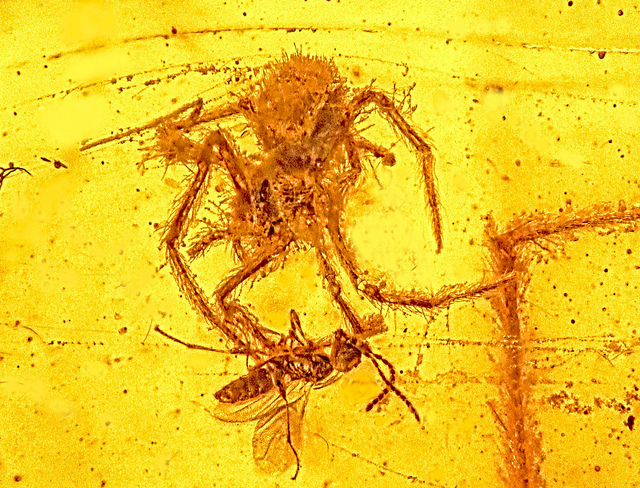There are a variety of ways to guarantee that a ghostly figure will appear on your photos, and none of them are supernatural.
Read MoreSpider and Prey Frozen in Amber

The amazing piece of amber pictured here is the only known example of a spider actually fossilized in the process of attacking its prey. Not only are the hairs of the spider and wings of the wasp perfectly preserved, the amber actually shows over a dozen intact threads of spider silk.
Normally I'd come up with a creepy description of what we're looking at here, but the good people at Oregon State University beat me to it.
“This was the wasp’s worst nightmare, and it never ended. The wasp was watching the spider just as it was about to be attacked, when tree resin flowed over and captured both of them.”
Read the whole article here.
Saola: the Asian Unicorn

As often as I mention mysterious, unknown creatures on this blog, I thought it'd be fun to remind ourselves just how incredible the diverse range of known species is. A great example is the Saola, which twenty years ago moved from the realm of legend into scientific recognition.
Found only along the Vietnam/Laos border, the Saola is the most recent large mammal whose existence has been recognized by western science. It was discovered in 1992 when a joint team of the Vietnamese Forestry Ministry and the WWF were conducting a survey of the Vu Quang Nature reserve. The scientists found three sets of long horns in hunter's dwellings; they knew that what they were seeing was of "great significance", and in a letter to the journal Nature, they announced their discovery.
Standing just under 3 feet high, Saola are stocky creatures which can weigh close to 200 lbs. Although resembling an antelope, they are more closely related to cattle. Known as "Asian Unicorns" due to their elusive nature, (there are still very few photographs of Saola in the wilderness, mostly coming from camera traps), a quick glance at the photo shows that from the side, it does appear to only have a single horn.
The story of the Saola is an inspiration not only to fans of legendary beasts, but to anyone who is astonished by the mysteries and beauty found all around us.
If you'd like to contribute to preserving creatures like the Saola, or just want to read more about the very real and amazing animals which share the world with us, check out the EDGE blog (Evolutionarily Distinct & Globally Endangered). They highlight animals which have unique characteristics, and which are not widely known.
Check out the Science Chamber of Horrors!
I've been a fan of the web-site Skulls in the Stars for some time now. It's a strange hodge-podge of discussions about physics, reviews of century old pulp fiction, and weird science facts; with those ingredients it's a natural that I'd love it!
I first came across the site when the (nameless) author was posting one strange science fact a day on twitter. Now the author has given the most bizarre and disturbing of those facts their own home: sciencehorrors.tublr.com
Here's a sort of mission statement from the first post:
As a physicist with a dual love of horror fiction and science/nature, over the past few years I’ve come across a number of creepy, freaky or genuinely horrifying things related to the natural world or those who study it.
Well worth checking out.
Oh, the Irony
From a NY Times article on the original production of Who's Afraid of Virginia Wolf:
I used to have my stage manager report back to me what people said in the theater as they left. One day, a typical Greenwich, Conn., woman — very hoity-toity, very hot potato, you know? — looked at her husband afterward and said, ‘Frederick, married people simply do not speak to each other that way, don’t you think?’ And he looked at her and said, ‘Ethel, for Christ’s sake, shut up.’
Even when conceived with racist undertones, great fiction can evolve.
Recently, I came across a blog post by Silvia Moreno-Garcia. She's working on an anthology call "Swords & Mythos" which is a crossing of Robert Howard-style Sword'N'Sorcery with good-ol' fashioned horrors beyond imagining, a la H.P. Lovecraft. (If that sounds fun to you, I encourage you to check out her Indiegogo fundraiser for the project.)
In her post Ms. Moreno-Garcia doesn't waste any time, but dives into the issue at hand with these opening lines:
What do you do when you are a person of colour (POC) planning an anthology inspired by the work of not one, but two racist writers? That’s my situation right now. I say you talk about it!
She then proceeds to clearly and intelligently lay out both her appreciation of the artistry of these two men, and also the disturbing depths of their racism. But she never falls into the trap of over-simplification, which is all too easy to do when dealing with topics like this.
People are not divided as villains and heroes. Lovecraft and Howard were not villains or heroes. They were men. Just as they could be very fun to hang out with, they also had their unpleasant side. We must accept this, and accept them as human beings with their quirks and their failings.
In the end, her article is about the importance of new voices and viewpoints, an absence of which for any genre means at best stagnation and more likely death. I agree with her, and it's not too much of an extrapolation to apply her points beyond genre to entire art forms, or even wider cultures.
I'd also like to mention that the comments section on her post is relatively free of the yammering and trolling that so often clogs up internet discussions, especially with hot-button topics such as race. Hats off to both Moreno-Garcia and her readers.
Check out the full post here.
Inspirational quote for the day...
Drawing is an escape from all the unnecessary things in life that get in the way of being free.
--Jamie Hewlett (Gorillaz, Tank Girl)
Feel free to swap in writing, singing, dancing, or whatever other place you may find your personal bliss.
More context on this quote at Cartoon Brew.
A techno-thriller for dinosaur nerds!
 Tyrannosaur Canyon by Douglas Preston
Tyrannosaur Canyon by Douglas PrestonMy rating: 4 of 5 stars
A techno-thriller for dinosaur nerds.
Although the cover art and blurbs present Tyrannosaur Canyon as a Jurassic Park knock-off, this book is about humans who chase fossils for both the brief glimpse into a lost world and the financial rewards which accompany it, all wrapped in the cloak of a fast-paced thriller.
Here's a bit of a disclaimer: I grew up wanting to be a paleontologist, and am predisposed to favor any story about this topic which is at least competently written. Douglas Preston's prose isn't brilliant, but it's certainly more than competent, and by the end I was glad that I'd picked this book up. If the story had revolved around stamps or antiques rather than tyrannosaurs and trilobites it would have still been a good airport read, but as it stands it was irresistible for me. (And frankly, the detail and affection with which Preston delves into the world of fossil hunting makes it obvious that he's more than a bit of a dinosaur nerd himself. That bit of passion from an author goes a long way toward giving life to any novel, regardless of topic or genre.)
Preston begins the mystery with the Apollo 17 moon landing, and he quite cleverly uses the actual dialogue from the mission transcripts to build the prologue for the story. From there we jump to the American Southwest in 2005, where a man is about to be killed as he returns from the site of a major find. By chance, a passerby hears the shot and tries to help the dying man. This good samaritan is Tom Broadbent, one of the main characters in an earlier Preston book (don't let this put you off-- I've never read that earlier book, and didn't feel that I was lost or walking into a sequel). Much as you'd expect, Tom and his wife are soon pulled into the crossfire as events spin out of control.
As in most thrillers, there are several villains, attacking our protagonists from several different vectors. As you'd expect, the villains with the most screen time are the most fleshed out, but I was disappointed to find that they were a bit of a mixed bag. While one heavy has outside interests and aspirations that round him out as a person, at least one had motivations which simply didn't ring true to my ear.
The science and weaponry details are there for geeks of multiple stripes; this is the kind of book that specifies what make and caliber of handgun is being waved under our hero's nose, while still finding time to ruminate on the different types of sediment thrown up by the impact which wiped out the dinosaurs.
Preston references paleontologists and bone hunters from the early days of museum expeditions to Bob Bakker, and mixes them effortlessly with car chases and kidnappings. (The desert wandering ex-CIA monk doesn't mix in so effortlessly, but hey-- they can't all be winners.)
Don't let the cover fool you-- it's no Jurassic Park clone, and Tyrannosaur Canyon is worth a read.
View all my reviews
Review: Dracula's Heir by Sam Stall
 Dracula's Heir: An Interactive Mystery by Sam Stall
Dracula's Heir: An Interactive Mystery by Sam StallMy rating: 4 of 5 stars
Dracula's Heir is an "Interactive Mystery", which means that every few pages there is a pull-out handwritten note or fold-out newspaper which the reader can examine for clues and/or hidden messages. Gimmicky? Sure, a damn fun gimmick.
As a kid I had a similar book-- that one based on A Study in Scarlet. I loved it then, and the appeal of physical interaction with clues is just as strong now. Though the book feels slight in the hand, the nature of the enclosed objects is such that readers will spend more time with it than the page count would indicate.
Dracula's Heir is geared for ages 10+; that's my guess-- there's no age recommendation on the book, but there are a couple sections which might be frightening for younger readers, especially as things pick up towards the end.
The book's mystery is nicely structured, with clues hidden along the way. Even better, the answer is revealed slowly, allowing readers of different ages/aptitudes to solve more or less of the puzzle as their their skills of detection allow.
View all my reviews
Looking for Primary Source Spider Tales
I get a good portion of my web traffic from people looking for info about the legendary Congolese giant spider-- the J'ba Fofi. I can't say as I'm too shocked by that, since it's a story that so fascinated me that when I started writing a blog, most everything that came out was somehow related back to it.
Most of what I know of the legend comes from secondary sources, where someone has put together a summary of the different stories, usually with a line like, "For centuries there have been legends..." or "Many natives say...". For some time I've been wondering if there's any collections of the folklore and legends of the Baka people, and the Congo area in general. I'd love to see exactly what the original legnds were, whether Anansi, some variation, or something else all together.
Does anyone out there have any recommendations for such spider-oriented folklore or urban legends? If so, drop a note in the comments section!
(As an aside, the best summation of secondary sources is easily Terrence Aym's article, "Possibility of the Existence of the Congolese Giant Spider". It's a great starting point for reading up on our large & legendary eight-legged friends. )

